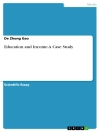To what extent does absolute freedom of expression exist? Is it necessary for journalists to seek refuge with foreign agencies to escape national governmental and policy restrictions? Should journalism education rely on international support, or is it feasible to detach it from foreign development collaboration? Should education be viewed as a business or commodity? Is any international development support sustainable within the local context? Is free thinking truly free from the structural constraints of slavery and financial influence? Is absolute freedom a utopian ideal or a tangible reality? These inquiries, coupled with corresponding philosophical methodologies, aim to evaluate the structure, constituents, excellence, and norms of current journalism education programs. The goal is to uncover if and to what extent international media development organizations sway journalism education programs during the transition phase (2011–2021) in Myanmar or beyond.
2011 marked a turning point, as the military-supported government of Myanmar granted media professionals the ability to exercise their fundamental rights
to express themselves and access information. The government has taken a number of favorable measures towards the democratic path, such as partially
lifting censorship from several news publications, authorizing private daily newspapers, approving new television channels, establishing a press council, and
permitting journalist unions and associations. The formation of the quasi-elected government in 2015 brought renewed hope. However, the military coup
at the beginning of 2021 has once again impeded progress towards a democratic environment, and fundamental rights such as access to information and freedom of speech. Capacity building facilities for journalists and media professionals remain an important aspect of the democratic process in the
country.
Spis treści
Abstract v
Kurzfassung vii
List of Tables and Figures xv
List of Abbreviations xxi
Chapter 1: Introduction 1
1.1 Idea and Status 2
1.2 Related Scientific Fields 4
1.3 Goals and Limitations of the Study 6
1.4 Structure of the Study 7
Chapter 2: Media Development Cooperation and Journalism Education 11
2.1 Media Development and Digitization 17
2.2 Development Theories: Historical Perspectives and Dimensions 40
2.2.1 Modernization Theory 47
2.2.2 Structuralism and Dependency Theory 52
2.3 Media Development and Democracy 56
2.4 Approaches to Formal and Non-formal Journalism Education 80
2.5 Approaches to Media Development Cooperation 94
2.6 Journalism Education as a Form of Media Development Cooperation 102
2.7 Sustainability and Media Development 112
2.8 The Role of International Media Development Organizations 119
2.8.1 Dimensions and Perspectives 119
2.8.2 Typology of International Media Development Organisations in Myanmar 120
2.8.2.1 IMDOs consulting on structural sustainability including PSB 126
2.8.2.2 IMDOs offering financial support in form of internships, scholarships, and fellowships 131
2.8.2.3 IMDOs offering technical supports with teachers and training materials 137
2.8.2.4 IMDOs offering platforms for media safety and security 141
2.8.2.5 IMDOs offering advocacy for the policy making level 144
2.8.2.6 IMDOs with the role of supporting trade unions in media houses 148
Chapter 3: Overall National and Regional Context 151
3.1 Historical, Geographical, and Political Context 151
3.2 Socio-Economic Development and Human Rights 160
3.3 General Education System 162
3.4 Media System and Journalism Culture 165
Chapter 4: Journalism Education in Myanmar 171
4.1 Journalism Education in Southeast Asia 171
4.2 Journalism Education Programs and Pathways in Myanmar 188
4.3 Existing Studies 191
Chapter 5: Study Design and Methodology 207
5.1 Hypothesis and Research Questions 207
5.2 Qualitative Research Approach 212
5.2.1 Sampling and Criteria for Interviewees 216
5.2.2 Semi-Standardized Focus Interviews 218
5.2.3 Category Scheme 221
5.2.4 Qualitative Content Analysis 223
5.3 Quantitative Research Approach 226
5.3.1 Quantitative Survey 226
5.3.2 Selection of Students and Trainees 230
5.3.3 Quantitative Data Analysis 231
Chapter 6: Empirical Research Results 235
6.1 Typical Journalism Educational Programs and Pathways 235
6.2 Institutional Collaboration 237
6.2.1 Collaboration between Journalism Education Institutions and Journalists Associations 237
6.2.2 Collaboration between Journalism Education Institutes and International Media Development Organizations 239
6.2.3 Collaboration between Journalism Education Institutes and Local Civil Society Organizations and Non-Government Organizations 240
6.2.4 Collaboration between Journalism Education Institutes and Human Rights Organizations 241
6.2.5 Collaboration between Journalism Education Institutes and Media Companies 242
6.2.6 Collaboration between Journalism Education Institutions and Other Institutions 243
6.3 Overall Educational Goals 243
6.3.1 General Educational Goals 243
6.3.2 Role and Relevance of Article 19 244
6.3.3 Additional Important Educational Goals 246
6.4 Intended Learning Outcomes 246
6.4.1 Professional Values 246
6.4.2 Integration of Human Rights Issues and Approaches 247
6.4.3 Human Rights Reporting 249
6.4.4 Media Production Skills 250
6.4.5 Practical Elements 251
6.4.6 Theoretical Knowledge 252
6.4.7 Specialized Knowledge 254
6.4.8 Additional Skills and Knowledge 255
6.4.9 Balance of Theoretical and Practical Knowledge 256
6.4.10 Integration of New Media 257
6.5 Aspects of Teaching 259
6.5.1 Educational and Professional Background of Instructors 259
6.5.2 Lacking in Competencies and Skills 261
6.6 Strength and Weakness of Journalism Education in Myanmar 263
6.7 Future Changes and Challenges 265
6.8 Influence of International Media Development Organizations on Journalism Education 267
6.8.1 Influence on Financial Aspects 267
6.8.2 Influence on the Content and Structure of Journalism Education Programs 269
6.8.3 Secondary Forms of Influence 271
6.9 Reflection of the Research Process 272
Chapter 7: Discussion on the Research Findings 277
Chapter 8: Conclusion 287
Bibliography 293
Appendix 1: List of Interviewees with Dates of Interviews 319
Appendix 2: Qualitative Interview Questionnaires 321
Appendix 3: Quantitative Survey Questionnaire 329
Appendix 4: Category Scheme 331












